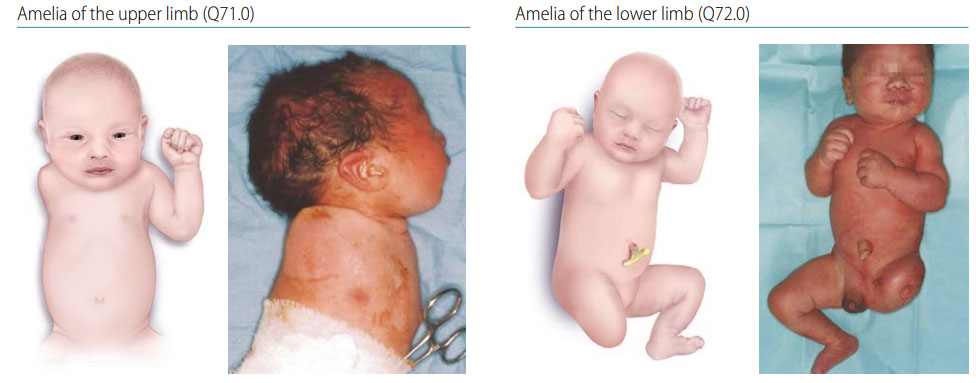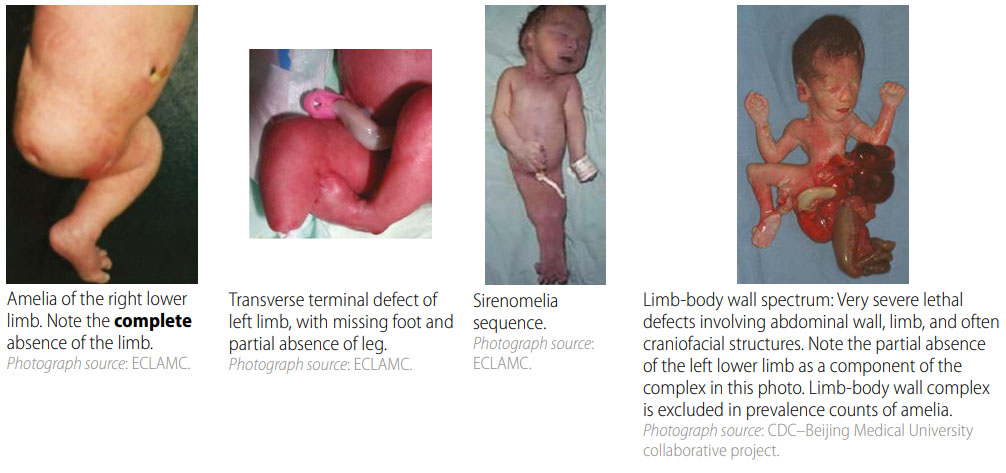Amelia
Amelia is a congenital anomaly characterized by the complete absence of one or more limbs (see Fig. 36). It can be distinguished from other limb deficiencies, especially terminal transverse deficiencies, and rare conditions such as sirenomelia and limb-body wall spectrum (see Fig. 37 and Table 2). Radiographs are strongly recommended to confirm the condition and characterize the bony anatomy.
Fig. 36. Amelia

Photograph source: CDC–Beijing Medical University collaborative project.
Diagnosis
Prenatal. Amelia can be diagnosed prenatally but can be missed or misdiagnosed. Cases identified or suspected prenatally should be confirmed postnatally before inclusion in a surveillance programme.
Postnatal. Careful examination of the newborn, aided by radiography, confirms the diagnosis of amelia and distinguishes it from other limb reduction defects (e.g. terminal transverse defects) and sirenomelia (very rare).
Clinical and epidemiologic notes
A carefully clinical examination is crucial, with special attention focused on confirming the absence of the proximal segment of the humerus or femur. Radiological examination is essential to firmly characterize the bony anatomy of the region.
- Multiple congenital anomalies are the most frequent. Amelia has been reported in association with musculoskeletal defects, intestinal defects, some renal and genital defects, oral clefts, defects of cardiac septa, and anencephaly.
- Though infrequently, amelia can be seen in certain syndromes, genetic (e.g., Roberts syndrome) as well as teratogenic (e.g., thalidomide embryopathy).
- Make sure that all bony segments of the affected limb are absent. If a segment is present, the defect is not amelia.
- Look for additional birth defects, not uncommon in cases with amelia.
Checklist for high-quality reporting
| Amelia – Documentation Checklist |
Describe in detail (avoid using only the term “amelia”), including:
|
Table 2. Distinguishing amelia from other congenital anomalies
| Congenital anomaly | Main features |
| Amelia | Complete absence of one or more limbs. |
| Transverse terminal defect | Terminal transverse limb deficiencies appear as an “amputation” of an arm, leg, or digit. Some remnant of the limb is present. |
| Sirenomelia sequence | Complex phenotype, with total or partial fusion of lower limbs, variably associated with sacral defects, anal atresia, malformed genitalia and renal a/dysgenesis. |
| Limb-body wall complex | Complex phenotype, consisting of a spectrum of anomalies, including limb deficiencies, atypical exencephaly/encephalocele, ventral body wall defects, atypical facial clefts, and at times, amniotic bands. |
Fig. 37. Distinguishing amelia from other congenital anomalies
